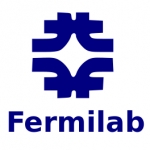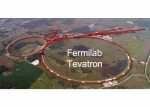Displaying items by tag: Fermilab
Fermilab
the Fermi National Accelerator Laboratory (Fermilab), located just outside Batavia, Illinois, near Chicago, is a US Department of Energy national laboratory specializing in high-energy particle physics.
As of January 1, 2007, Fermilab is operated by the Fermi Research Alliance, a joint venture of the University of Chicago, Illinois Institute of Technology and the Universities Research Association (URA). Fermilab is a part of the Illinois Technology and Research Corridor.
Fermilab's Tevatron was a landmark particle accelerator; at 3.9 miles (6.3 km) in circumference, it was the world's second largest energy particle accelerator (CERN's Large Hadron Collider is 27 km in circumference), until being shut down on September 30, 2011. In 1995, both the CDF and DØ (detectors which utilize the Tevatron) experiments announced the discovery of the top quark.
In addition to high energy collider physics, Fermilab is also host to a number of smaller fixed-target and neutrino experiments, such as MiniBooNE (Mini Booster Neutrino Experiment), SciBooNE (SciBar Booster Neutrino Experiment) and MINOS (Main Injector Neutrino Oscillation Search). The MiniBooNE detector is a 40-foot (12 m) diameter sphere which contains 800 tons of mineral oil lined with 1520 individual phototube detectors. An estimated 1 million neutrino events are recorded each year. SciBooNE is the newest neutrino experiment at Fermilab; it sits in the same neutrino beam as MiniBooNE but has fine-grained tracking capabilities. The MINOS experiment uses Fermilab's NuMI (Neutrinos at the Main Injector) beam, which is an intense beam of neutrinos that travels 455 miles (732 km) through the Earth to the Soudan Mine in Minnesota.
Tevatron
The Tevatron was a circular particle accelerator in the United States, at the Fermi National Accelerator Laboratory (also known as Fermilab), and holds the title of the second highest energy particle collider in the world after the Large Hadron Collider (LHC) near Geneva, Switzerland.
The Tevatron was a synchrotron that accelerated protons and antiprotons in a 6.86 km, or 4.26 mi, ring to energies of up to 1 TeV, hence its name. The main achievement the Tevatron was discovery in 1995 of the top quark—the last fundamental fermion predicted by the standard model of the particle physics. On July 2, 2012, near the end of Tevatron's operation, scientists of the CDF and DØ collider experiment teams at Fermilab announced the findings from the analysis of around 500 trillion collisions produced from the Tevatron collider since 2001, and found that the existence of the suspected Higgs boson was highly likely with only a 1-in-550 chance that the signs were due to a statistical fluctuation. The findings were confirmed two days later as being correct with a likelihood of error less than 1 in a million by data from the LHC experiments.
The Tevatron was completed in 1983 and significant upgrade investments were made in 1983–2011. The Tevatron ceased operations on 30 September, 2011,[3] due to budget cuts and because of the completion of the LHC, which began operations in early 2010 and was far more powerful (planned energies were two 7 TeV beams at the LHC compared to 1 TeV at the Tevatron). The main ring of the Tevatron will probably be reused in future experiments, and its components may be transferred to other particle accelerators.


